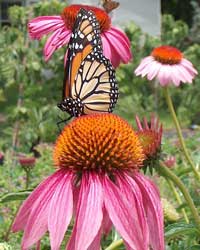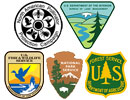Things You Can Do
Learn for a Lifetime

Photo by Anne Marie Conard.
Take some time to learn about monarch butterflies as well as other pollinators and their habitats. Where do you start?
- Print and electronic media offer a staggering amount of information on every aspect of monarch butterfly biology, distribution, and conservation.
- Search the Internet for information about the monarch butterfly.
- Contact your local public or university library. Library staff can direct you to reference materials useful to the beginner as well as those already knowledgeable about monarch butterflies.
- Local organizations such as garden clubs, your state’s native plant society, Master Gardener’s Program, Master Naturalist’s Program, and other nature-oriented groups may be great monarch butterfly resources. These organizations and groups often offer public programs about wildflowers, pollinators, butterflies, and monarch butterfly conservation.
- Visit a nearby botanic garden or arboretum. They are vast resources of information and offer many workshops, field tours, and lectures open to the public.
- The Monarch Watch Reading Room has some great information about monarch butterfly resources.
- Take a class about your local butterflies and wildflowers at a nearby community college.
- Attend local Earth Day activities in your town or participate in National Pollinator Week activities.
Practice Good Stewardship
Be a thoughtful consumer and a good citizen of planet earth. Garden responsibly, avoiding species that are invasive and may escape into the local environment. Many native plants and natural areas are threatened by competition from invasive species.
Butterfly Gardening

Butterfly garden. Photo by Janet Mukai.
Use native plants in your butterfly gardens, as they are the species that monarch butterflies have always depended upon. Native plants are adapted to your local environment and do not require the extra care that plants from far away places require. When incorporating native plants into your landscape, make sure they are not wild-collected. When hiking through your favorite natural areas, enjoy the monarchs and native wildflowers and make note of their preferred nectar plants, but do not collect them from the wild.
Garden-worthy butterfly plants are often available from seed exchanges and native plant nurseries. Your local native plant society can provide you with a list of reputable local nurseries and garden centers that sell native plants beneficial to monarchs and other pollinators.
- Celebrating Wildflowers Native Gardening
- Celebrating Wildflowers Native Plant Materials
- Celebrating Wildflowers Invasive Plants
- Celebrating Wildflowers: Ethics and Native Plants
Use care when using herbicides and pesticides. These chemicals can negatively affect non-target species. Rather than broadcasting herbicides or pesticides, spot treat. Overall, limit your use of herbicides and pesticides. Look for natural ways to reduce weeds or pests (flytraps, pheromone traps, or hand pulling weeds). Hire professionally trained Integrated Pest Management personnel who use physical controls and low toxicity products to manage pests.
Become a Certified Monarch Waystation
Register your butterfly garden as a Monarch Waystation and assist in the conservation of the monarch butterfly in North America.
Be an Advocate
Find out what is planned for your neighborhood, your city, your state, and your national wildlife refuges, national forests and grasslands, and other federal public lands. These are public lands, your lands. Speak up for conservation of butterflies, especially monarchs, native plants and their habitats. The agencies responsible for the management of our public lands invite public comment about their plans for managing, developing, and regulating public lands. Embrace your civic privilege and make your voice heard.

Photo by Charles and Diane Peirce.
Join
Join a group that supports butterfly and plant conservation. At local, state, national, and international levels there are many organizations that need your support, and will welcome you as a member. Attending meetings of these organizations will be an enjoyable and enlightening opportunity. You will meet other folks who are concerned about monarchs and other butterflies and their habitats. The fellowship you will experience will inspire you, and your enthusiasm will inspire others, to care for delicate yet amazing insects.
Share Your Knowledge and Passion
Others that came before you led butterfly walks, taught local butterfly wildflower classes, and in so many ways shared their knowledge and passion about monarchs and the native plants they depend upon. They did so willingly. Now it is your turn to carry the torch, to pass along the knowledge and passion needed to keep our monarch butterflies and their habitats thriving. Your enthusiasm will be catching.
- Invite your family and friends along for a walk through a wildflower meadow and keep an eye out for monarch butterflies, larvae, and even those tiny monarch eggs.
- Learn the milkweeds native to your area.
- Volunteer to make a presentation in your town, especially at your local elementary or middle school. Help children make deep connections with nature that will last them all their lives.
Become a Citizen Scientist

Volunteers capturing and tagging monarch butterflies. Photo by Anne Okonek.
No public land management agency has the staff or the budget to carry out all the necessary tasks to conserve and manage monarch butterflies and monarch habitats. Many agencies and organizations provide training enabling people to conduct monarch monitoring, give public programs, and lead public interpretive walks.
Donate
If you able, donate your time, talents, books, and monarch butterfly photographs to schools, community groups, garden clubs, or conservation groups.

